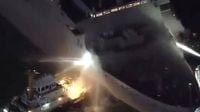A fierce fire broke out aboard the USS New Orleans, a US Navy warship, while it was anchored off Okinawa, Japan, on Wednesday, August 20, 2025. The blaze, which raged for nearly 12 hours, left two sailors with minor injuries and prompted a massive overnight firefighting effort involving American and Japanese forces. The incident has sparked renewed scrutiny over fire safety procedures on US Navy vessels, especially in light of past disasters.
The USS New Orleans, a San Antonio-class amphibious transport dock ship, was anchored at the White Beach Naval Facility on the east coast of Okinawa when the fire erupted around 4 p.m. local time, according to a statement from the US Navy's 7th Fleet (CNN). The ship, which measures 684 feet in length and has a displacement of 24,000 tons, can carry more than 360 sailors and up to 800 troops. Despite the scale of the incident, the Navy confirmed that only two sailors suffered minor injuries and were treated in on-board medical facilities. The crew remained on board after the fire was extinguished (Bhawana Gariya, August 21, 2025).
Firefighting efforts continued through the night, with the crew of the New Orleans battling flames alongside assistance from the nearby USS San Diego, which was also moored at White Beach. The Japan Coast Guard, Japan Maritime Self-Defense Force, and other US Navy commands on Okinawa provided crucial support. Four Japanese vessels—including coast guard, naval, and contractor ships—joined the operation, spraying water onto the burning ship until the situation was stabilized (CNN; Bhawana Gariya).
Images broadcast by Japanese public broadcaster NHK showed tugs dousing the front of the New Orleans with water, highlighting the intensity of the response. According to the Japan Coast Guard, firefighting efforts did not officially end until just after 9 a.m. local time on Thursday, August 21, even though the Navy had declared the fire extinguished earlier that morning. Investigators from both the US and Japan are now working to determine the cause of the blaze (CNN).
The USS New Orleans, commissioned in 2007, serves as a key staging platform for US Marines and their equipment, enabling rapid deployment to amphibious ships. The White Beach Naval Facility, where the ship was anchored, plays a strategic role in supporting US military operations in the region. The incident comes at a time when the US maintains a significant military presence in Japan, with approximately 54,000 personnel stationed there—most of them in Okinawa (Bhawana Gariya).
The fire has drawn immediate comparisons to a previous disaster: the 2020 fire aboard the USS Bonhomme Richard in San Diego. That blaze burned for over four days, ultimately leading to the billion-dollar ship being scrapped. A subsequent Navy investigation found the Bonhomme Richard fire was the result of "a series of systemic failures, including a failure to maintain the ship, ensure adequate training, provide shore support, or carry out oversight" (CNN). In the wake of that disaster, the Navy implemented new inspection and training procedures designed to prevent such incidents from recurring.
Yet, as former US Navy captain and analyst Carl Schuster noted, "A fire of that extent used to be rare on US Navy warships." Schuster told CNN that the damage from the New Orleans fire could leave the ship out of action for 60 to 120 days—a significant setback for the Navy's operational readiness in the region. "The New Orleans fire shows the Navy needs to again review and improve its fire prevention and firefighting procedures," Schuster added, underscoring the ongoing challenge of managing fire risks aboard complex warships.
Fires are always a danger on naval vessels, Schuster explained, because they carry a considerable amount of flammable material. The lessons from the Bonhomme Richard disaster remain fresh: losing a ship, even temporarily, can disrupt service readiness for years and have far-reaching implications for military strategy and logistics. The Navy's efforts to strengthen safety protocols since 2020 were meant to address precisely these vulnerabilities, but the New Orleans incident suggests that more work may be needed to ensure such tragedies do not repeat themselves (CNN).
The immediate response to the fire on the USS New Orleans demonstrated both the professionalism and the cooperation between US and Japanese forces. The Navy's 7th Fleet praised the "critical support" provided by local partners, including the Japan Coast Guard and Maritime Self-Defense Force. The presence of four Japanese vessels, including contractor tugs, was instrumental in bringing the fire under control. This joint effort highlights the close military ties between the US and Japan, especially in Okinawa, where American forces play a crucial role in regional security (Bhawana Gariya; CNN).
Despite the ordeal, the Navy confirmed that the USS New Orleans' crew would remain on board while the investigation continues. Maintaining the integrity of the ship and protecting its sensitive equipment are top priorities, as is ensuring the well-being of its sailors. The Navy has not specified the extent of the damage, but the estimate that repairs could take up to four months points to a significant disruption in the ship's operations (CNN).
As the cause of the fire remains under investigation, questions linger about what sparked the blaze and whether existing protocols were sufficient to contain it quickly. The Navy has indicated that the review will be thorough, drawing on lessons from past incidents like the Bonhomme Richard fire. The outcome of the probe could influence future training, maintenance, and oversight policies across the fleet.
For the residents of Okinawa, who have long lived alongside a large US military presence, the fire is a reminder of both the risks and the responsibilities that come with hosting such forces. While the incident did not result in fatalities or major injuries, it has reignited debates over safety, preparedness, and the broader role of the US military in the region.
Ultimately, the fire aboard the USS New Orleans is more than an isolated mishap; it is a test of the Navy's ability to learn from past mistakes and to safeguard its personnel and assets in a challenging environment. The coming weeks will reveal not only the cause of the fire but also whether the Navy's renewed focus on safety will be enough to prevent another disaster from striking the fleet.




